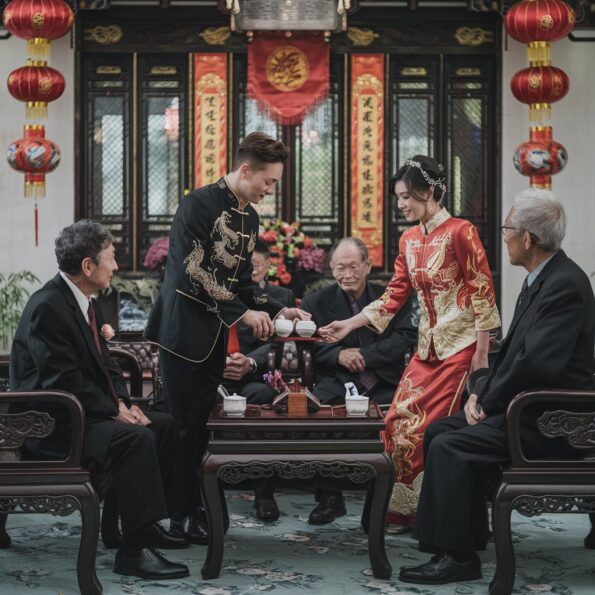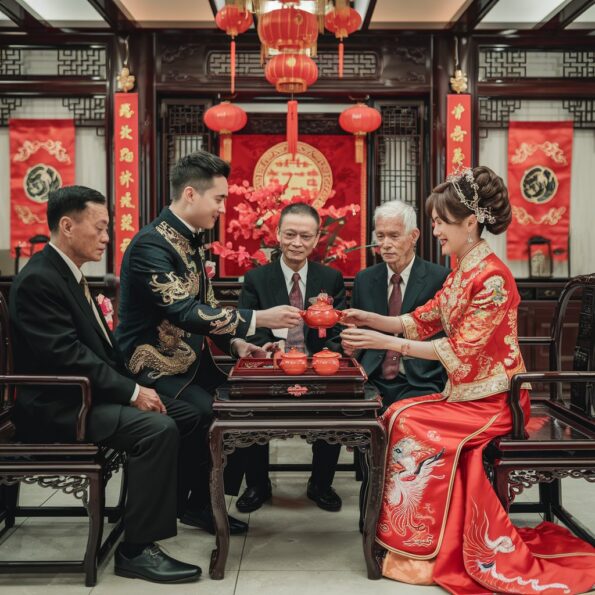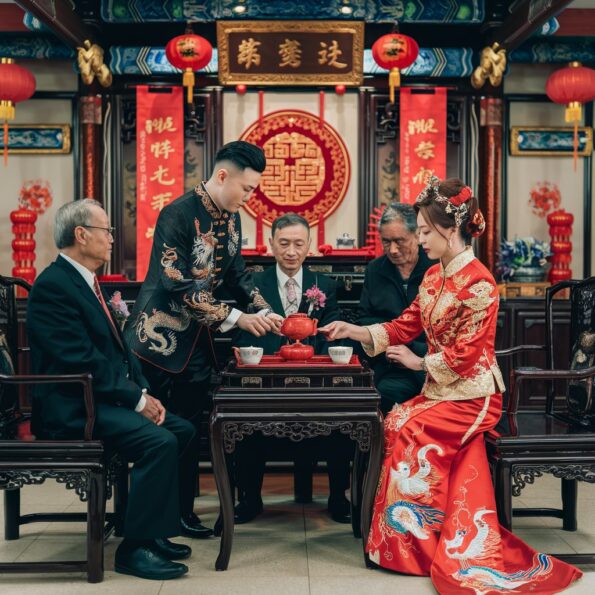Introduction to the Chinese Wedding Tea Ceremony
The Chinese wedding tea ceremony holds deep cultural significance, symbolizing respect and gratitude towards family elders. This cherished tradition allows the couple to honor their parents and grandparents, acknowledging the love and care they have received throughout their lives.
Originating during the Tang Dynasty, the tea ceremony has been a cornerstone of Chinese weddings for centuries. During this ritual, the bride and groom serve tea to their families, a practice that has been passed down through generations. This ceremony reflects the profound customs and values rooted in Chinese culture.

The tea ceremony is rich in symbolic meaning, representing the union of two families. It serves as a gesture of appreciation from the couple to their elders, acknowledging the upbringing and support they have received. It also marks the beginning of their new life together.
In modern times, many couples choose to hold a joint tea ceremony for both families rather than separate ones. This adaptation reflects the evolving nature of the tradition, accommodating contemporary wedding practices while still honoring the essence of the ceremony.
The structure of the ceremony typically involves serving tea to parents, grandparents, and other elders in order of seniority. This order is crucial, as it demonstrates the couple’s respect for their family’s hierarchy and traditions.

Traditional Groom Attire
The Tang Suit, a quintessential choice for grooms, features a long sheath paired with a jacket, often embellished with intricate dragon embroidery. This attire not only exudes elegance but also embodies the cultural richness of Chinese heritage, making it a popular choice for traditional weddings.
The Changshan, another traditional option, consists of a long robe typically paired with a Ma Gua jacket. This ensemble, crafted from luxurious silk, is often seen in vibrant colors like red and gold, which symbolize prosperity and joy in Chinese culture.
These garments are steeped in cultural symbolism, with dragons representing strength and honor. The use of red and gold further enhances the auspicious nature of the attire, aligning with themes of good fortune and happiness.
Traditional Chinese wedding attire reflects the groom’s respect for his cultural heritage and family values. By donning these garments, grooms pay homage to their ancestors and uphold the traditions that have been passed down through generations.
These traditional outfits are often complemented by the bride’s attire, such as the Qun Kwa or Cheongsam. This pairing not only creates a harmonious visual aesthetic but also signifies the unity and balance between the couple.

Modern Groom Attire
Many grooms today opt for a modern suit with a red tie, incorporating traditional colors into their ensemble. This choice seamlessly blends Western formal wear with a nod to Chinese cultural heritage, where red symbolizes happiness and good fortune. The red tie serves as a vibrant focal point, ensuring the groom stands out while honoring tradition.
A popular choice that combines modern style with traditional elements is the Mandarin collar jacket. This jacket, often adorned with intricate embroidery, offers a sophisticated look that pays homage to Chinese heritage. The Mandarin collar adds a unique touch, setting it apart from typical Western suits.
Modern attire may include brocade ties or bowties featuring dragon motifs. Brocade fabric, known for its rich texture and elaborate patterns, adds a touch of luxury and cultural significance. The dragon motif, symbolizing strength and good fortune, is a popular choice for grooms who wish to incorporate traditional elements into their modern attire.
While red remains a traditional color, modern attire may also feature other colors like black or gold. Black offers a sleek, contemporary look, while gold symbolizes wealth and prosperity. These color variations allow grooms to personalize their attire while still embracing elements of Chinese culture.
Modern groom attire allows for a blend of Western and Chinese styles, reflecting personal taste and cultural heritage. This cultural fusion is evident in choices like pairing a Western suit with a traditional Chinese jacket or incorporating Chinese motifs into modern designs. This approach celebrates the groom’s heritage while embracing contemporary fashion trends.
Cultural Significance of Attire
In Chinese weddings, attire serves as a profound expression of respect and tradition. The groom’s choice of clothing is not merely a personal preference but a tribute to family customs and a gesture of reverence towards elders.
The groom’s attire is a reflection of his commitment to family values and cultural heritage. By donning traditional garments, he signifies his dedication to preserving the customs that have been passed down through generations.
Traditional Chinese wedding garments are rich with symbolic elements. Embroidered dragons and phoenixes are common, representing strength, harmony, and the auspicious union of the couple.
Wearing traditional attire connects the groom to his ancestors, creating a tangible link to family history. This generational connection serves as a powerful reminder of the enduring legacy of familial bonds.
For the groom, traditional attire is a declaration of cultural identity and pride. It is a way to celebrate his heritage and showcase the rich tapestry of Chinese culture to the world.
Color Symbolism in Attire
Red is a color deeply embedded in Chinese culture, symbolizing happiness, good fortune, and prosperity. It is the most popular choice for wedding attire, often seen in the bride’s qipao or cheongsam. This vibrant hue is believed to ward off evil spirits and bring joy to the couple’s new life together.
Gold, with its shimmering allure, represents wealth and nobility in Chinese culture. It is often used in combination with red to create an opulent and auspicious look. Gold accents can be found in the bride’s dress, jewelry, and even the wedding decorations, symbolizing a prosperous future for the couple.
In contrast, white and black are colors associated with mourning and death in Chinese culture. These colors are typically avoided in wedding attire to prevent any negative connotations. Instead, the focus is on vibrant and auspicious colors that bring joy and positivity to the celebration.
The combination of red and gold is particularly favored in Chinese weddings. This pairing not only creates a visually stunning appearance but also embodies the harmonious blend of happiness and prosperity. The use of these colors together is believed to enhance the auspiciousness of the wedding day.
Colors in Chinese wedding attire carry deep cultural meanings and are chosen to reflect positive attributes. Each color used in the wedding attire and decorations is carefully selected to ensure it brings the desired blessings and good fortune to the couple. This cultural significance adds a layer of depth and tradition to the celebration.
Choosing the Right Outfit
When selecting attire for the tea ceremony, personal style and comfort should be prioritized. The groom might choose a Tang suit or a modern suit with a red tie, reflecting his taste while ensuring ease of movement.
Family expectations play a crucial role in attire selection. Traditional garments like the Chang Pao Ma Gua may be preferred by families with strong cultural ties, symbolizing respect for ancestral customs.
Balancing modern style with traditional elements is essential. A groom might opt for a Zhongshan suit, which merges Eastern and Western styles, honoring cultural heritage while embracing contemporary fashion.
Practical considerations are vital, ensuring the outfit is comfortable for the ceremony’s duration. Lightweight fabrics and breathable designs are recommended for long ceremonies, especially in warmer climates.
Incorporating symbolic elements like dragons and phoenixes in attire can reflect the couple’s values and aspirations, symbolizing harmony and prosperity in their marriage.

This revised version maintains the depth and cultural significance of the original content while enhancing the clarity and flow of the information presented.



